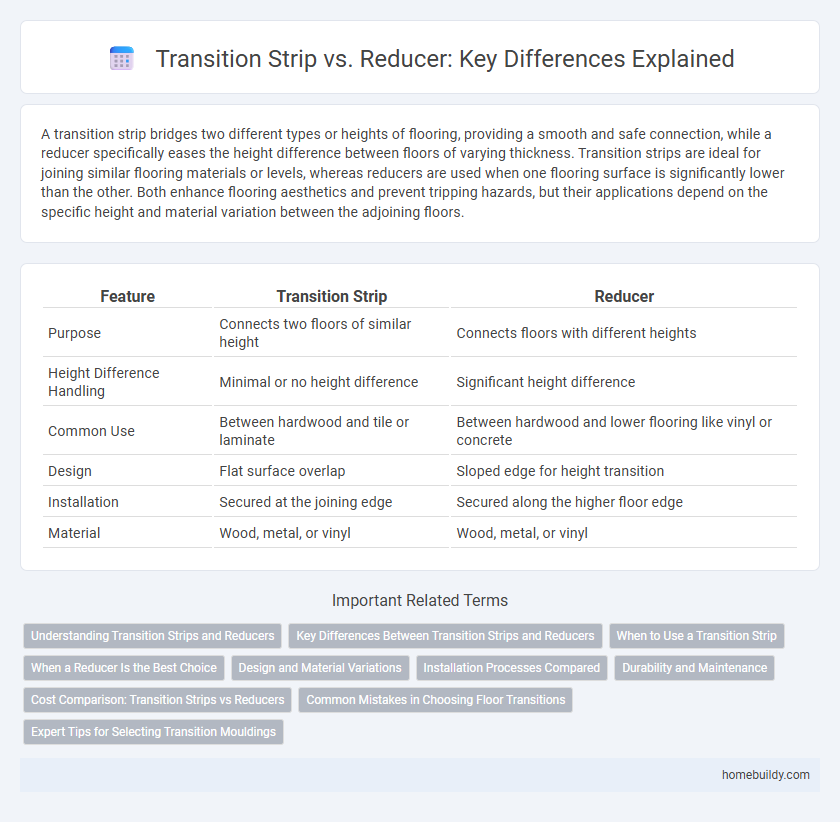A transition strip bridges two different types or heights of flooring, providing a smooth and safe connection, while a reducer specifically eases the height difference between floors of varying thickness. Transition strips are ideal for joining similar flooring materials or levels, whereas reducers are used when one flooring surface is significantly lower than the other. Both enhance flooring aesthetics and prevent tripping hazards, but their applications depend on the specific height and material variation between the adjoining floors.
Table of Comparison
| Feature | Transition Strip | Reducer |
|---|---|---|
| Purpose | Connects two floors of similar height | Connects floors with different heights |
| Height Difference Handling | Minimal or no height difference | Significant height difference |
| Common Use | Between hardwood and tile or laminate | Between hardwood and lower flooring like vinyl or concrete |
| Design | Flat surface overlap | Sloped edge for height transition |
| Installation | Secured at the joining edge | Secured along the higher floor edge |
| Material | Wood, metal, or vinyl | Wood, metal, or vinyl |
Understanding Transition Strips and Reducers
Transition strips and reducers serve distinct purposes in flooring installation, with transition strips bridging two floors of equal height and reducers connecting floors of differing heights. Transition strips ensure a smooth, visually appealing seam between similar surfaces, while reducers taper the higher floor down to meet the lower floor, preventing tripping hazards and damage. Selecting the appropriate profile depends on floor elevation differences and the desired aesthetic finish.
Key Differences Between Transition Strips and Reducers
Transition strips are designed to connect two flooring surfaces of similar height, providing a smooth and safe passage between rooms, while reducers accommodate height differences between floors, tapering one surface down to meet the other. The key difference lies in their functionality: transition strips maintain consistent floor levels, whereas reducers manage uneven floor transitions to prevent tripping hazards. Material compatibility and installation methods also vary, as reducers require precise angling to blend different floor heights seamlessly.
When to Use a Transition Strip
Use a transition strip when connecting two floors of the same height but different materials, ensuring a smooth and safe boundary between surfaces such as hardwood and tile. Transition strips effectively cover expansion gaps and prevent tripping hazards in areas with minor height variations but consistent floor elevation. This makes them ideal for doorways, hallways, or rooms where a clean visual break is needed without changing floor height dramatically.
When a Reducer Is the Best Choice
A reducer is the best choice when transitioning between flooring surfaces of different heights, such as from hardwood to vinyl or laminate, as it provides a smooth, gradual slope to prevent tripping hazards. Unlike transition strips, which are ideal for floors of the same height, reducers accommodate height differences up to 1/2 inch or more, ensuring a seamless and safe transition. Choosing a reducer enhances aesthetic appeal and functionality in spaces with varied floor elevations.
Design and Material Variations
Transition strips and reducers both serve to connect flooring surfaces but vary significantly in design and material options. Transition strips typically feature flat or slightly raised profiles suitable for joining floors of equal height, available in materials such as wood, metal, and vinyl to match diverse decor styles. Reducers, designed with a tapered edge, accommodate differences in floor height, commonly crafted from hardwood, aluminum, or laminate to ensure smooth and aesthetically pleasing transitions between floors.
Installation Processes Compared
Transition strips and reducers both serve to bridge flooring surfaces but differ in installation complexity. Transition strips typically involve a straightforward fastening method using screws or adhesives directly into the subfloor, suitable for surfaces of similar heights. Reducers require careful adjustment since they accommodate height differences between floors, often necessitating precise cutting and additional anchoring for a secure fit.
Durability and Maintenance
Transition strips offer enhanced durability compared to reducers, as they are designed to accommodate slight height differences between flooring types without bearing heavy stress. Maintenance for transition strips is generally simpler, requiring only occasional cleaning and inspection, while reducers may need more frequent adjustments due to their role in gradually decreasing floor height and potential wear at the edges. Choosing a transition strip typically results in a longer-lasting flooring solution with lower upkeep needs.
Cost Comparison: Transition Strips vs Reducers
Transition strips generally cost less than reducers due to their simpler design and easier installation process, making them a budget-friendly option for connecting flooring surfaces of similar heights. Reducers are typically priced higher because they accommodate height differences between flooring types, requiring more material and precise fitting. Choosing between the two depends on the specific flooring transition needs and budget constraints.
Common Mistakes in Choosing Floor Transitions
Confusing transition strips with reducers often leads to improper flooring alignment and uneven surfaces, causing tripping hazards and premature wear. Transition strips are designed to connect two floors of the same height, while reducers accommodate height differences between floors to ensure a smooth slope. Selecting the wrong floor transition compromises aesthetic continuity and functional safety, emphasizing the need to evaluate floor height and material differences carefully.
Expert Tips for Selecting Transition Mouldings
Transition strips provide a seamless connection between flooring surfaces of equal height, while reducers are designed to bridge floors of differing heights, preventing trip hazards. Experts recommend measuring floor height differences accurately and choosing mouldings made from durable materials like hardwood or metal to ensure longevity and aesthetic appeal. Selecting the appropriate transition moulding enhances safety, maintains flooring integrity, and improves the overall visual flow in interior spaces.
Transition strip vs Reducer Infographic

 homebuildy.com
homebuildy.com